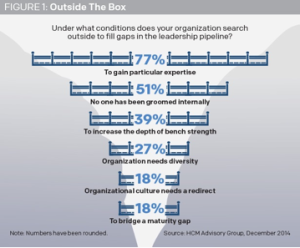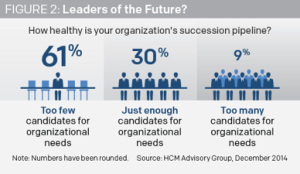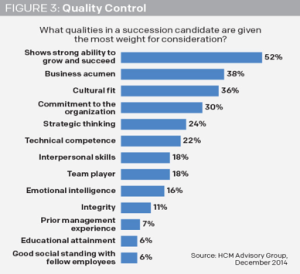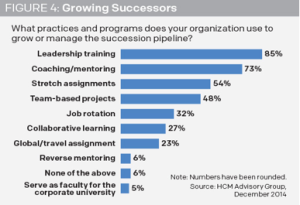More than half of organizations don’t have enough internal candidates to fulfill their succession planning needs, according to recent research.

Outside of wanting to gain a particular expertise, the other top reason hiring executives and HR practitioners say their firms go outside is because no one has been groomed internally, according to the survey (Figure 1).
Other reasons a company might search outside to fill leadership gaps are: increase the depth of bench strength, improve the organization’s diversity and change the company culture and bridge a maturity gap.
While a majority of participating organizations reported having at least some form of a succession plan, about 60 percent said their organizations have too few candidates to fill their succession needs (Figure 2).
Respondents said they identify high-potential talent mostly through performance reviews and conversations with managers. Other methods were informal identification, skills testing and personality assessments. Fewer than 20 percent of respondents said they used analytics or third-party recruiting platforms to identify employees with high potential, the survey showed.
Qualities that make an employee attractive as a succession candidate include business acumen, cultural fit, commitment to the organization, strategic thinking, technical competence, interpersonal skills, the ability to be a team player, emotional intelligence, and integrity.
Moreover, roughly 52 percent of respondents said the most important quality in succession candidates is that they show a strong ability to grow and succeed (Figure 3).
To grow or manage the succession pipeline, 85 percent of respondents reported that their firms implemented some form of leadership training (Figure 4).
Other initiatives favored include coaching and mentoring programs, stretch assignments, team-based projects and job rotation.
Meanwhile, methods such as collaborative learning, travel assignments, reverse mentoring and serving as faculty for the corporate university were also used but to a lesser extent, the survey showed.
Although the process of succession planning is most often the job of a company’s human resources and talent management departments, other members of the organization are often involved as well.
About 70 percent reported the involvement of C-suite executives in succession planning, while others said line management and boards of directors played a role. Learning and development, talent acquisition, and diversity and inclusion staff also occasionally take part, the survey showed.
Still, just 14 percent reported that diversity and inclusion officers were included in succession planning. That’s even though 65 percent of respondents rated diversity as a “medium” priority in the process.
Likewise, respondents reported succession planning was not very integrated in their organization’s diversity and inclusion programs. Just more than 20 percent said succession planning was mostly or completely integrated in their firm’s diversity and inclusion efforts.
Organizations, meanwhile, gauge the effectiveness of their succession plan using a variety of metrics. The majority of respondents said bench strength readiness is the most-important metric.Other measurements included retention of high-potential employees, the rate of internal hires compared with external hires, pipeline utilization, skills gap analysis and the percentage of roles filled.To a lesser extent, respondents also used metrics such as the amount of time taken for an employee to be fully operational in a new role, the length of a worker’s tenure in a new position and cost analysis.





